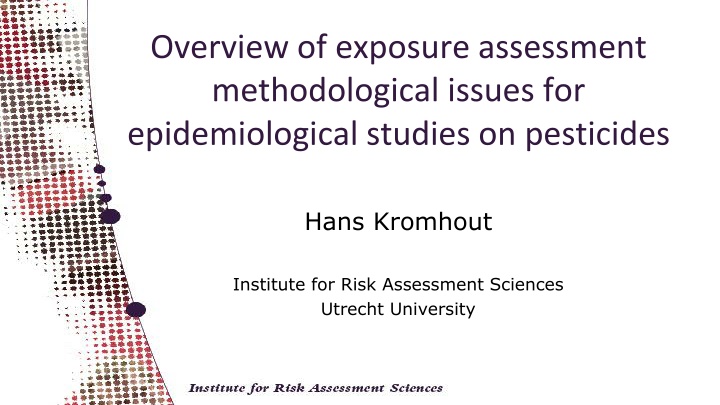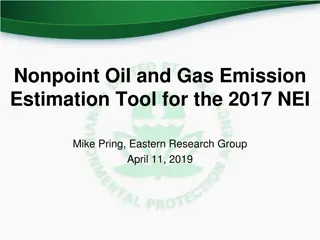
Exposure Assessment Methodological Issues in Epidemiological Studies on Pesticides
Explore the challenges in assessing agricultural exposure to pesticides, with a focus on the nature of exposures, variability in concentrations, and potential misclassification issues. Learn about the complexities faced by farmers and workers, as well as the significant variations in exposure levels based on different factors such as outdoor work, intermittent processes, and specific types of agents. Gain insights into the inhalation and dermal exposure databases, highlighting the risks associated with pesticide exposure in various occupational settings.
Download Presentation

Please find below an Image/Link to download the presentation.
The content on the website is provided AS IS for your information and personal use only. It may not be sold, licensed, or shared on other websites without obtaining consent from the author. If you encounter any issues during the download, it is possible that the publisher has removed the file from their server.
You are allowed to download the files provided on this website for personal or commercial use, subject to the condition that they are used lawfully. All files are the property of their respective owners.
The content on the website is provided AS IS for your information and personal use only. It may not be sold, licensed, or shared on other websites without obtaining consent from the author.
E N D
Presentation Transcript
Overview of exposure assessment methodological issues for epidemiological studies on pesticides Hans Kromhout Institute for Risk Assessment Sciences Utrecht University
Farmers (used to be) Conservative Stable: career and residency Knowledgeable Well-informed (by extension workers) Fond of their work So what s the problem when we want to study their agricultural exposure? 2
Nature of exposures in agriculture Seasonal Often outdoors Highly variable Type of agent and exposure Biological, chemical and physical Individual agents (active ingredients) Intensity, duration and frequency 3
Given nature of exposures in agriculture and potential for misclassification It is a miracle we find any exposure-response relation at all 4
How bad is it? Based on inhalation exposure database (Kromhout et al. Annals Occup Hyg 1993): Individuals working outdoors in intermittent process have on average: Day-to-day concentrations vary up to a factor 150 Between-worker averages vary up to a factor 10 Individual working indoors in intermittent process have on average: Day-to-day concentrations vary up to a factor 90 Between-worker averages vary up to a factor 10 5
How bad is it? Based on dermal exposure database (Kromhout & Vermeulen, Annals Occup Hyg 2001): For re-entry workers exposed to pesticides on average: Day-to-day concentrations vary up to a factor 10-40 No between-worker differences in average exposure For sheep dippers: Day-to-day concentrations vary up to a factor 300 Between-worker averages vary up to a factor 30 Huge differences between body parts!!! 6
Fruit growers exposed to Captan during re-entry Captan in NL 1991 and 1992 Type N K bwR.95 wwR.95 Inhalation 154 108 3.1 541 Dermal wrist 188 133 17.3 143 Dermal hands 182 128 45.1 65.3 7
Relative contributions of main tasks and routes to exposure to Captan (de Cock et al. 1996) Farmer Son Wife Farmer Son Wife Inhalable exposure Dermal exposure Growing season 4% 1% 0% 6% 2% 0% Application 95% 98% 91% 84% 87% 47% Re-entry 1% 1% 9% 10% 11% 53% Home Inhalable exposure Dermal exposure Harvesting season 2% <1% 0% 3% <1% 0% Application 97% 99% 98% 89% 93% 84% Re-entry <1% <1% 2% 7% 5% 17% Home 81 88 33 440 468 211 8 Total amount
Consequences for epidemiological research Generic questions possible in general population based studies (case-control) resulting in considerable contrast between exposed and non- exposed Studies within agriculture suffer from lack of contrast and lack of accuracy and precision Using measurements will not necessarily result in more accurate exposure assessment since: Mixed exposure situations Large variability (not enough data available) Good modelling practices needed 9
Used Methods Self-reports Expert-assessment Job-exposure matrices Crop-exposure matrices Algorithms (determinants of exposure) 10
Self-reports versus expert assessment case-control neuroblastoma (Daniels et al. 2001) Very low prevalence (3.8% fathers, 0.7% mothers) Fathers an OR of 1.5 (0.7-3.4) (comprehensive OH review) Self-reports substantially higher: 7.5% and 3.4%, but 49% of fathers and 80% of mothers were unlikely to have been exposed; showed no relation with outcome Exposure classification based on job title showed opposite patterns; mothers an OR of 3.2 (0.9-11.7) Standardized and validated questions focussing on determinants needed 11
JEMs For the general population we need exposure assessment to be very specific because of the low prevalence: only individuals with a high probability of exposure should be assigned exposure to pesticides As long as we make the exposure axis not to specific we will be fine For agricultural cohorts we will need more detailed job and agent axes Crop Exposure Matrices 12
CEMs Crop exposures rely often on registration data But multiple pesticides can be used on a specific crop Also same pesticide can be used on multiple crops Results in a very sensitive method, but given the high prevalence within agricultural studies this shouldn t be too problematic However it will result in (heavily) correlated exposures 13
Agricultural Health Study Algorithm (Dosemeci et al. 2002) So will semi-quantitative methods as elaborated by Dosemeci work? Algorithm scores appear to provide a reasonably valid measure of exposure intensity (Coble 2005); but appeared marginally predictive of forearm captan exposure and did not predict air, hand rinse or urinary THPI exposures (Hines 2008); improved algorithm(Coble 2011) Re-entry exposure component (with most likely a longer duration) has to be included (Negatu 2016) We cannot change anything about the mixed and highly variable exposure environment of the applicator 14
Conclusions If you are looking for positive results when studying chronic effects of pesticides exposures, go for the case-control design and study the general population. (You will need large studies) We will only find meaningful relationships between pesticides exposures and chronic health effects if we know how to deal with the inherent large temporal and spatial variability in these exposures 15
Thank you very much for your attention! 16









